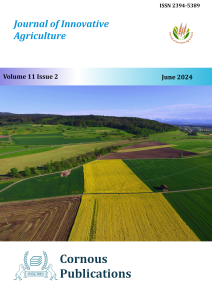
Journal of Innovative Agriculture
Peer Reviewed Open Access Journal
ISSN: 2394-5389 NAAS Rate: 4.05
Submit Manuscript
Peer Reviewed Open Access Journal
ISSN: 2394-5389 NAAS Rate: 4.05
Submit ManuscriptBackground: Prominence and demand for sesame is high, however, its production remains quite low. Scarcity of labour is one of the constraints to carry out the key operations in time, wherein delayed operations result in low productivity. The newly evolved non-branching type sesame is amenable for farm mechanization. Optimizing the crop geometry is a pre-requisite to step further for mechanizing the newly evolved monostem sesame cultivation. Keeping these aspects in view, field evaluations were conducted to evaluate the yield potential of non-branching monostem sesame VRI 5.
Methods: The newly evolved non branching monostem sesame VRI was evaluated with eight set of treatments viz., T1 - 30 x 30 cm, T2 - 30 x 15 cm, T3 - 30 x 10 cm, T4 - 20 x 20 cm, T5 - 20 x 15 cm, T6 - 20 x 10 cm, T7 - 30 x 20 x 10 cm in paired row, T8- 30 x 15 x 10 cm in paired row during two seasons viz., Summer 2021 and Summer 2022. The experiment was laid out in three replications following randomized block design.
Results: Higher plant height at harvest (88.1 cm), number of nodes per plant (14.1) and internode length (5.38 cm) were noted at a wider spacing of 30 x 30 cm. However, a higher seed yield of 770 kg/ha was recorded at a square geometry of 20 x 20 cm.
Conclusion: Based on the two consecutive years of field experiment it is ascertained that the crop geometry at a spacing of 20 x 20 cm is ascertained to be optimum in recording higher productivity of monostem sesame VRI 5.
monostem sesame, crop geometry, spacing, productivity
Agudamu, T. Yoshihira., & Shiraiwa, T. (2016). Branch development responses to planting density and yield stability in soybean cultivars. Plant Production Science, 19(3), 331– 339.
Ali, A. Y. A., Guisheng, Z., Hassan, A., Yagoub, S. O., Farah, G. A., Ahamed, N. E., ... & Omer, S. M. (2020). Sesame seed yield and growth traits response to different row spacings in semi-arid regions. Univers. J. Agric. Res., 8(4), 88-96.
Bhardwaj, H. L., Hamama, A. A., Kraemer, M. E., & Langham, D. (2014). Sugars in whole sesame seed: effects of cultivars, planting dates and row spacings. American Journal of Experimental Agriculture, 4(9), 978-984. https://doi.org/10.9734/AJEA/2014/8999
Caliskan, S., Arslan, M., Arioglu, H., & Isler, N. (2004). Effect of planting method and plant population on growth and yield of sesame (Sesamum indicum L.) in a Mediterranean type of environment. Asian J. Plant Sci., 3(5), 610-613.
Demeke, B., Dejene, T., & Abebe, D. (2023). Traits association and path coefficient analysis of yield and yield attributing traits of upland rice (Oryza sativa L.) genotypes at pawe, northwestern Ethiopia. Journal of Innovative Agriculture, 10(4), 21-30.
Gomez, K. A., & Gomez, A. A. (1984). Statistical procedures for agricultural research. John Wiley & Sons.
Hamza, M., El-Fattah, H.M.A., & Safina, S.A. (2022). Maximizing sesame crop yield via matching the appropriate genotype with the optimum intra-row spacing. International Journal of Agricultural Research, 17, 22-31.
Harisudan C., & Vincent, S. (2019). Enhancing source-sink partitioning efficiency and productivity of sesame. Madras Agricultural Journal, 106(7/9), 488-491.
Harisudan, C., (2020). Climate change mitigation strategies by altering crop canopy for enhancing heat unit efficiency and sustainable productivity of sesame (Sesamum indicum L.). Journal of Oilseeds Research, 37(168).
Harisudan, C., Sapre, N., & Manivannan, V. (2020). Effect of altered crop canopy and plant growth promoters on sesame productivity. Asian Journal of Biological Sciences, 13, 253-257.
Jakusko, B.B., Usman, B.D., & Mustapha, A.B.. (2013). Effect of row spacing on growth and yield of Sesame (Sesamum indicum L.) in Yola, Adamawa State, Nigeria. Journal of Agriculture and Veterinary Science 2(3), 36-39.
Jan, A., Ali, S., Adail, M., & Khan, A. (2014). Growth and yield components of sesame (Sesamum indicum L.) as influenced by phosphorus levels under different row spacing. Growth, 4(22).
Lakew, S., Ayalew, D., & Assefa, F. (2018). Optimum inter-row spacing and seeding rate of sesame for harnessing the maximum productivity potential in the dry land area of Abergelle District, Northeast Ethiopia. Cogent food & agriculture, 4(1), 1485471.
Luca, M.J. de., & Hungría, M. (2014). Plant densities and modulation of symbiotic nitrogen fixation in soybean. Scientia Agricola., 71(3), 181–187.
Mohammed, B., Abba, G., & Ibrahim, B. S. (2019). Effect of inter-row spacing on the yield attributes of sesame (Sesamum Indicum L.) varieties in northern part of Sokoto, Nigeria. Global Academic Journal of Agricultural Science, 1, 25-29.
Nadeem, A., Kashani, S., Ahmed, N., Buriro, M., Saeed, Z., Mohammad, F., & Ahmed, S. (2015). Growth and yield of sesame (Sesamum indicum L.) under the influence of planting geometry and irrigation regimes. American Journal of Plant Sciences, 6(07), 980-986.
Pereira-Flores, M.E., & Justino, F.B. (2019). Yield components and biomass partition in soybean: climate change vision. In soybean-biomass, yield and productivity. IntechOpen.
Roy, N., Abdullah, S. M., & Jahan, M. S. (2009). Yield performance of sesame (Sesamum indicum L.) varieties at varying levels of row spacing. Research Journal of Agriculture and Biological Sciences, 5(5), 823–827.
Sumathi, P., & Muralidharan, V. (2010). Inheritance of branching and important biometrical traits in sesame (Sesamum indicum L). Indian Journal of Genetics and Plant Breeding, 70(1), 97–101.
